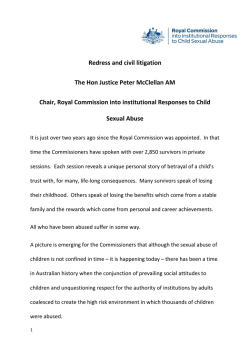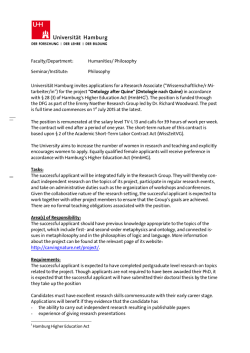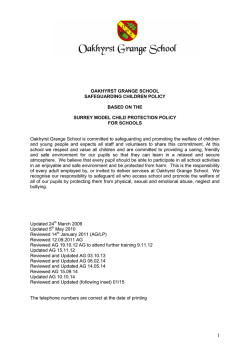
Ch 2 - What we have done - Royal Commission into Institutional
161 7 Redress scheme processes 7.1 Introduction For a redress scheme to work effectively for all parties, its processes must be efficient and focused on: • obtaining the information required to determine eligibility and calculate monetary payments • making that determination and calculation fairly and in a timely manner. Redress schemes processes, and the way in which the scheme is administered, must be sensitive, transparent and survivor-centred, so that they minimise any risk of re-traumatisation and maximise the benefit of redress. As discussed in relation to monetary payments in Chapter 6, redress scheme processes will have a significant impact on the application of a scale of payments and the overall cost of monetary payments under redress. Accordingly, redress scheme processes must be settled in close alignment with actuarial assessments of scheme costs and the sustainability of scheme funding. Previous and current redress schemes provide many examples of effective and less effective processes. 7.2 Key redress scheme processes Through our private roundtables, we consulted a number of survivor advocacy and support groups, institutions, governments and academics on these elements of redress scheme processes. The approaches we proposed on these elements were, on the whole, supported through the private roundtables, although there are clearly different views that can be taken on a number of them. We have refined or explained some of them further in response to the consultations. Eligibility for redress An effective redress scheme must clearly define eligibility for the purposes of the scheme. Eligibility refers to the criteria that determine whether a person is able to obtain redress through the scheme. The key elements to consider for eligibility are: • the types of institutions included • the connection required between the institution and the abuse • the type of abuse included Royal Commission into Institutional Responses to Child Sexual Abuse childabuseroyalcommission.gov.au 162 • any cut-off date by which the abuse must have occurred • whether those who have already received redress may apply. Types of institutions included The definition of ‘institution’ in our Terms of Reference is very broad. We appreciate that no previous or current scheme has such broad coverage (other than statutory victims of crime schemes, which apply to all criminal abuse regardless of whether it has any connection with an institution). Even the broad government schemes have been limited by, for example, excluding foster care (Queensland), only covering residential institutions (although Western Australia included foster care), or only covering those who were in formal state care (Tasmania). However, we have not heard anything that suggests to us that any particular entities or types of entity that are included in the definition of ‘institution’ in our Terms of Reference should be excluded from the coverage of a redress scheme. It is apparent that there must in fact be an institution involved in the arrangement in which abuse is said to have occurred. In particular, abuse in foster care and kinship care should be covered by a redress scheme, as these out-of-home care arrangements are organised and overseen by institutions. However, abuse in voluntary foster care or kinship care arrangements that are not organised or overseen by an institution should not be covered by a redress scheme. Connection required between the institution and the abuse It is also necessary to consider what degree of connection is required between the institution and the abuse in order to be eligible for a redress scheme. Our Terms of Reference define child sexual abuse as occurring within an institutional context if: • it happens on premises of an institution, where activities of an institution take place, or in connection with the activities of an institution; or • it is engaged in by an official of an institution in circumstances (including circumstances involving settings not directly controlled by the institution) where [we] consider that the institution has, or its activities have, created, facilitated, increased, or in any way contributed to, (whether by act or omission) the risk of child sexual abuse or the circumstances or conditions giving rise to that risk; or • it happens in any other circumstances where [we] consider that an institution is, or should be treated as being, responsible for adults having contact with children. It seems likely that the abuse covered by a redress scheme should be that for which the institution can reasonably be said to be responsible. This might include all abuse committed in a closed, residential institution, including peer-on-peer abuse. However, it may not include all peer-on-peer abuse on day school premises, for example if the abuse occurred on school premises out of school hours or during school holidays. Similarly, instances of family or stranger abuse committed on institutional premises, or abuse committed by a stranger Consultation Paper on Redress and Civil Litigation 163 while a child is in foster care may be instances where an institution cannot reasonably be said to be in any way responsible for the abuse. A satisfactory approach may be that abuse should be included for redress if: • it happens on premises of an institution, where activities of an institution take place, or in connection with the activities of an institution, in circumstances where the institution is, or should be treated as being, responsible for the contact in which the abuse was committed between the abuser and the applicant • it is engaged in by an official of an institution in circumstances (including circumstances involving settings not directly controlled by the institution) where the institution has, or its activities have, created, facilitated, increased, or in any way contributed to, (whether by act or omission) the of risk abuse or the circumstances or conditions giving rise to that risk • it happens in any other circumstances where the institution is, or should be treated as being, responsible for the adult abuser having contact with the applicant. Type of abuse included Our Terms of Reference require us to examine child sexual abuse within an institutional context. Our Terms of Reference also acknowledge that child sexual abuse ‘may be accompanied by other unlawful or improper treatment of children, including physical assault, exploitation, deprivation and neglect’. The issue here is whether a redress scheme should be limited to child sexual abuse or whether it should also extend to physical abuse of children or other forms of abuse or neglect. Some current redress schemes are focused on sexual abuse. The South Australian Government scheme carried out through its statutory victims of crime compensation scheme applies only to sexual abuse. The Salvation Army Eastern Territory scheme applies only to ‘sexual misconduct’, although it then allows for assessment of other matters, including physical assault and emotional abuse, in assessing monetary payments. However, most previous and current redress schemes cover at least sexual and physical abuse. Some also extend to emotional abuse or neglect. A number of submissions from survivors and survivor advocacy and support groups advocated including all forms of abuse, not just sexual abuse. We are satisfied from what we have heard in private sessions and case studies that physical abuse and neglect may accompany, and make worse, sexual abuse, particularly in residential institutions. As discussed in Chapter 6, we consider that physical abuse accompanying sexual abuse may affect the severity of the abuse, and that this should be taken into account in assessments under a redress scheme. Having regard to our Terms of Reference, it would not be appropriate for us to consider making recommendations about redress for physical abuse or neglect that is unrelated to sexual abuse. Royal Commission into Institutional Responses to Child Sexual Abuse childabuseroyalcommission.gov.au 164 Cut-off date by which the abuse must have occurred We have heard a range of views regarding whether a redress scheme should apply to past and future occurrences of abuse. On balance, most of those who expressed views in our consultation processes to date have advocated redress being available for future occurrences of abuse, and not just for past occurrences of abuse. The Actuaries Institute submitted that an option that is ‘more likely to be sustainable’ would be to limit the period of abuse that a redress scheme covers to: any past abuse of living persons, where the first episode of abuse occurred prior to the trigger date [that is, the cut-off date]. If abuse occurred both before and after the trigger date, then it will be covered. Any case where the first episode of abuse occurs after the trigger date would not be part of the scheme. 214 On balance, we are inclined to think that this is the best approach. We are not suggesting that the only avenue for seeking redress for any future occurrences of abuse should be civil litigation. Rather, it is not clear that the particular form of redress or redress scheme we recommend for past abuse will be necessary or adequate for future occurrences of abuse. We consider that the work of the Royal Commission as a whole is likely to change the dynamics between survivors and institutions, including in relation to redress. In particular, any reforms to civil litigation may well alter views about what ‘justice’ is in relation to redress. It is also unlikely that as large a cohort of survivors as currently exists (particularly Forgotten Australians, Former Child Migrants and members of the Stolen Generations) could be created through failures of policy and inaction in the future. We consider that a redress scheme should cover ‘past’ abuse – that is, abuse that has already occurred or that occurs between now and the date on which civil litigation reforms commence. This would not prevent institutions or governments deciding in future to extend a redress scheme or run additional redress schemes. As discussed in Chapter 2, we welcome submissions on this issue. Whether those who have already received redress may apply We have discussed our proposed approach to this issue when discussing monetary payments in Chapter 6. In short, we propose those who have already received redress through previous and current government and non-government redress schemes, including statutory victims of crime compensation schemes, or through civil litigation, should remain eligible to apply to the scheme. However, these previous payments should be adjusted for inflation and then deducted from any proposed monetary payment. Clearly, survivors who have already received monetary payments greater than the maximum monetary payment under the scheme would effectively be ineligible for any further monetary payment. Determining eligibility for counselling and psychological care may be more difficult, particularly if a substantial settlement has been paid in civil litigation given that the settlement would be expected to cover all future medical expenses. It may be Consultation Paper on Redress and Civil Litigation 165 appropriate for the scheme to provide guidance to potential applicants on whether any previous monetary payment would exclude them from eligibility for counselling and psychological care under the scheme (in addition to any monetary payment). It would also be important for survivors who have already received redress through previous or current redress schemes to understand that the assessment processes and levels of payments may be different. In particular, a survivor who received the maximum payment under Redress WA or the Queensland Government scheme, for example, should not assume that they would receive the maximum payment under the new redress scheme. The scheme should provide appropriate guidance and support to survivors through the application process to assist them to maintain realistic expectations. Applicants will need to be asked for, and will need to provide, information about any previous redress or compensation they have received. However, we have seen examples of situations where survivors have difficulty accurately recalling previous redress or compensation they have received and who do not have accurate records. Subject to addressing any privacy concerns through obtaining applicants’ consent, the redress scheme may be able to negotiate arrangements with prior government redress schemes to confirm any redress the applicant has already received. Information about any redress or compensation already paid could also be sought from the relevant institution. Duration of a redress scheme Whether a redress scheme is open-ended or has a fixed closing date has significant implications for survivors who may be eligible for the scheme, and for those responsible for funding and administering the scheme. A redress scheme may be finite or ongoing. Previous and current redress schemes provide examples of both. The Queensland and Western Australian government schemes were each finite, as was the Tasmanian Government scheme, except that it was extended several times to allow additional rounds of applications. Statutory victims of crime compensation schemes are ongoing, although some impose time limits on applications from the date of the crime. Non-government institution redress schemes, such as Towards Healing, tend to be ongoing, although some smaller non-government institution redress schemes have operated for fixed times only. The main argument against having a fixed closing date is that eligible survivors may miss out on redress because they do not find out about the scheme until after the closing date, when it is too late for them to apply. We have heard from a number of survivors and survivor advocacy and support groups that this was a problem with Redress WA. The Western Australian Government recognised this issue to some extent when it established a further scheme for those abused while resident in country high school hostels who had not realised that they were eligible to apply under Redress WA. 215 Although there was an extensive communication strategy to promote the availability of Redress WA, we have been told by a number of survivors and survivor advocacy and support groups that survivors may be particularly difficult to reach, and some survivors may not Royal Commission into Institutional Responses to Child Sexual Abuse childabuseroyalcommission.gov.au 166 appreciate that a scheme is available to them. In particular, although Redress WA targeted remote Indigenous communities through its communication strategy, we have been told that a number of survivors in these communities did not realise that they might be eligible for Redress WA until other community members received payments, by which time applications had closed and it was too late for them to apply. 216 There are other difficulties with having a fixed closing date. Many survivors may find it difficult to describe their abuse sufficiently for the application process in the time allowed. Some survivors may not be ready to discuss their abuse for the purposes of a redress scheme at that time. Further, because of these difficulties, there may be many applications still to be completed in the lead-up to the fixed closing date. This can place considerable pressure on survivors and support services given that they are trying to complete applications to ensure that survivors’ claims are put before the redress scheme in adequate detail for them to be fairly and properly assessed. We acknowledge that open-ended schemes may be considerably more difficult for those who fund and administer them. Having finite government schemes in Western Australia and Queensland enabled claims to be assessed and monetary payments to be determined in accordance with scheme budgets (including the increased budget for Redress WA). It also enabled all claims to be determined over a reasonably short period of time. This is likely to have improved consistency and fairness between survivors. Finite schemes may also encourage more efficient administration and reduced administrative costs. However, given what we know about how long it may take survivors to disclose their abuse, it could be expected that a redress scheme would need to be available for some 20 or more years after the last occasion of abuse it is intended to cover.217 Of course, when a redress scheme opens, it could also be expected that many survivors will be ready and waiting to apply. This is particularly the case with groups such as the Forgotten Australians, Former Child Migrants and the Stolen Generations, which have participated in inquiries, have prominent advocacy and support groups, and in many cases have been pursuing redress for abuse from well over 20 years ago. Other survivors may need some years before they are ready to apply. Given that fixed closing dates create significant difficulties for survivors and they particularly risk excluding eligible survivors, we consider that a scheme should not have a fixed closing date. If applications dwindle to the point where the need for the continued operation of the scheme is questioned, it may be that the scheme can be closed. However, this should only occur after the closing date has been given widespread publicity and at least a further 12 months for applications to be made has been allowed. Publicising and promoting the availability of the scheme A key feature of an effective redress scheme is a comprehensive communication strategy. This strategy should ensure that the availability of the scheme is widely publicised and promoted. Consultation Paper on Redress and Civil Litigation 167 Much can be learned from the communication strategies used by previous government schemes, although it may be necessary to update strategies to include wider use of social media. A mix of mass, niche and direct marketing might be considered. Some survivors are likely to be difficult to reach. An effective communications strategy should target hard-to-reach groups. Some groups may be reached best through promoting the scheme to survivor advocacy and support groups, other support services and community legal centres. Some survivors may not be reached through these strategies. However, having no fixed closing date for a redress scheme will remove some of the urgency in reaching all survivors quickly to promote the availability of the scheme and allow them sufficient time to apply. This will allow more survivors, including survivors who might not be in contact with support groups or services, to be reached through word of mouth. The Royal Commission acknowledges that communication strategies need to be tailored to overcome any barriers that particular groups within the community may face. Particular communication strategies could be considered for people who might be more difficult to reach. For example, specific materials and content could be created to engage with: • Aboriginal and Torres Strait Islander communities • people with disability • culturally and linguistically diverse communities • regional and remote communities • people with mental health difficulties • people who are experiencing homelessness • people in correctional or detention centres • children and young people. Careful consideration should be given to how best to reach these groups. Redress WA and the Queensland redress scheme may provide useful examples to consider. Application process Survivors and survivor advocacy and support groups have overwhelmingly called for the application process for redress to be as simple as possible to minimise the risk of retraumatisation. An application process must obtain the information necessary to assess eligibility and determine the amount of any monetary payment. It should do this as efficiently as possible and in a manner that ensures that applicants have a good opportunity to put forward the best application they can. However, as noted above in Chapter 6, a scheme may require additional material or ‘evidence’ and additional procedures to determine the validity of claims if it has higher maximum or average payments available. Royal Commission into Institutional Responses to Child Sexual Abuse childabuseroyalcommission.gov.au 168 Based on all that we have heard to date, it appears that the basic application process should rely primarily on completion of a written application form. The form should be designed and tested before it is used to ensure that it is as simple as possible, while seeking all of the necessary information. It is apparent that the scheme should fund a number of support services and community legal centres to assist applicants to apply for redress. This was done in both the Western Australian and Queensland government schemes. The support services and community legal centres that are chosen should cover a broad range of likely applicants, taking into account the need to cover regional and remote areas, and to take account of particular needs of different groups of survivors, including Indigenous survivors. Despite the use of service providers to assist applicants, Redress WA reported considerable variability in the quality of written applications. 218 It seems likely that some applications were not adequately completed because of time pressures. Having no fixed closing date for a redress scheme should reduce these difficulties. Further, the scheme should ensure that it communicates clearly and regularly with the service providers, so that there is no doubt as to what is required. There is an issue as to whether, if survivors retain their own lawyers to assist them in applying for redress, the fees lawyers can charge survivors should be capped. Redress WA adopted an approach of contacting each applicant by telephone to give them an opportunity to add to the account they had given in their application and to answer any queries that Redress WA had about their application. Redress WA reported that the telephone conversations were critical in balancing out the varying quality of the initial applications, although some applicants found the telephone calls distressing and traumatising.219 This difficulty might be best addressed by working with service providers to ensure that they understand what is required in application forms. Given that applications will be determined on the basis of information provided in the application form, it is in applicants’ interests to submit forms only when they are as complete as reasonably possible. Again, not having a fixed closing date for the scheme should assist. Some survivor advocacy and support groups have suggested that every applicant should be given an oral hearing so that they have an opportunity to tell their story. Conducting a hearing for each application may substantially slow down the determination of applications and increase administrative costs. Some survivors and survivor advocacy and support groups have also reported bad experiences of hearings that were part of redress schemes. There may need to be some provision for oral hearings where the written application process is unable to ensure that the applicant’s case has been fairly and adequately made. However, unless an applicant has insurmountable difficulties in completing a written application even with the assistance of available support services, an oral hearing should not be needed for applications to be fairly and properly assessed and determined. As noted above, there may also be a need for oral hearings, additional material or ‘evidence’ and additional procedures to determine the validity of claims if the scheme has higher Consultation Paper on Redress and Civil Litigation 169 maximum or average payments available. Additional requirements could apply only for those applications that might be assessed at the medium to higher levels of severity under the table or matrix, rather than for all applications. For example, a scheme might require medical evidence, psychological or psychiatric reports, and an oral hearing before deciding to offer larger monetary payments. The scheme might also wish to consider the outcome of any disciplinary investigations before determining an application if the abuse is recent or fairly contemporary and the alleged perpetrator is still involved with the institution. The Western Australian and Queensland government schemes required applicants to verify their accounts of abuse by statutory declaration. We see no harm in requiring applicants to verify their accounts of abuse, including the impact of the abuse, by statutory declaration, particularly as service organisations can help applicants to understand the nature and effect of a statutory declaration. Further, if an applicant has a copy of a previous application they have made for redress, or another document in which they have recorded an account of the abuse and its impact, we see no difficulty in the application process allowing them to attach the previous account, along with any supplementary information the applicant wishes to provide, and verifying that account by statutory declaration. Institutional involvement Many survivors and survivor advocacy and support groups have told us that they consider that decisions about redress, particularly the determination of any monetary payment, must be made by a body independent of the institutions in which the abuse occurred. A number of institutions have also called for independent decision-making processes to be established, although some have expressed reservations about the need for independence and the timeliness of decision making in an independent scheme. The structure of an independent, ‘one-stop shop’ redress scheme envisages independent decision making by either a national or separate state and territory schemes. Of course, these schemes would not be independent of the government or governments that are involved in establishing and administering them. We have not heard any complaints about a lack of independence in the previous government redress schemes run in Tasmania, Western Australia and Queensland comparable with the complaints made about some nongovernment institutions’ schemes. (There have been complaints about other aspects of the previous government redress schemes, but not their independence.) It seems likely that this approach would provide sufficient independence to address the concerns that survivors and survivor advocacy and support groups raise. However, independent decision making does not mean that there should be no role for the institution. It is apparent that the scheme should provide any institution that is the subject of an allegation with details of the allegation, and should seek from the institution any relevant records, information or comment. The institution may also indicate that it accepts the allegations, although it would still be necessary for the redress scheme administrators to determine the abuse and impact in accordance with the scheme’s decision-making processes. Royal Commission into Institutional Responses to Child Sexual Abuse childabuseroyalcommission.gov.au 170 It seems to us to be particularly important that institutions should be provided with details of the allegations to ensure that institutions are aware of abuse that is alleged to have occurred in connection with their operations. Many institutions have already dealt with many allegations. However, some institutions have told us that they had no allegations of abuse made against them in circumstances where we have heard allegations made against them in private sessions. It does not seem to us to be desirable that institutions not know as early as possible about any allegations involving them that are made through a redress scheme. In particular, if an allegation is made against a person who is still involved with the institution, the institution may have to act on the allegation independently of any issues of redress. The relevant institution may be well placed to confirm or challenge the presence of the applicant and alleged abuser at the institution at the relevant time. The institution might also have relevant information about other allegations against the alleged abuser, and information about any previous redress or compensation provided to the applicant for the alleged abuse. Standard of proof The standard of proof determines the degree to which a decision maker must be satisfied of an allegation in order to accept it as true. Current and previous redress schemes have adopted different standards of proof, although how different they are in practice seems to us to be questionable. Through our private roundtables, we considered the following possible standards of proof: • the balance of probabilities, which is the standard of proof that generally applies in civil litigation. It requires that the matters alleged must be more probable than not, in order to be accepted as true • the higher civil standard of proof discussed by Dixon J in Briginshaw v Briginshaw (1938) 60 CLR 336, which requires that, the more serious an allegation, the more ‘reasonably satisfied’ of its truth the decision maker must be before it can be accepted as true • plausibility, which requires that the decision maker be satisfied that the allegations are plausible and may be true. There are other possible standards. For example, the Senate Community Affairs References Committee recommended a ‘reasonable likelihood’ standard of proof when it recommended that the Australian Government establish a national reparations fund for victims of abuse in institutions and out-of-home care settings.220 A standard of reasonable likelihood would be higher than plausibility but lower than the balance of probabilities. We have heard a variety of views from our consultation processes as to which of these standards of proof should be adopted. We acknowledge that, the higher the amount of monetary payments available, the more reasonable it might be for a scheme to adopt a higher standard of proof. However, we also recognise that the monetary payments we are considering do not, and are not intended to, provide compensation equivalent to common law damages. Further, as noted above, a Consultation Paper on Redress and Civil Litigation 171 scheme could require additional material or ‘evidence’ and additional procedures to determine the validity of claims if it has higher maximum or average payments available, without adopting a higher standard of proof as such. Another argument against adopting a standard of proof used in civil litigation is that past experience suggests that, even if a scheme purports to apply the civil standard of proof, it seems that a lower standard is actually applied, at least in determining whether or not the abuse occurred. Often, there is no ‘witness’ other than the applicant, and there is no other ‘evidence’ against which an applicant’s allegation of abuse can be balanced. The decision for the decision maker is, essentially, simply whether or not, or to what extent, they believe the applicant’s allegations. It may be that this is best reflected in a plausibility test or a test of reasonable likelihood. Of course, more ‘evidence’ may be needed to determine the severity of the impact of the abuse, including material such as medical evidence and psychological or psychiatric reports. If a civil standard of proof is adopted, the scheme would need to adopt a process that allowed the rebutting or testing of the applicant’s allegations. This may require contested hearings. Because we do not propose that a scheme should attempt or purport to make any finding that any named person was involved in any abuse, there is no need to adopt the standards of proof applied in civil litigation for this reason. Decision making on a claim A redress scheme structure that provides for independent decision making by either a national scheme or separate state and territory schemes should provide sufficient independence of decision making from the institution in which the abuse occurred. The previous government redress schemes in Western Australia and Queensland provide examples of administrative decision-making processes within large-scale schemes. An approach that provides for levels of delegation, with assessments of more serious abuse or impact to be determined by more senior staff, seems appropriate. Through our consultations, there was strong support for a mix of expertise in decision making. A mix of legal, medical, psychosocial and similar skills, including experience in issues relating to institutional child sexual abuse, is likely to ensure that properly informed decisions are made. The mix of skills should be designed to ensure that matters requiring assessment under the matrix for determining monetary payments can be properly understood by drawing on appropriate expertise. It is unlikely that every decision will need to be made using the full mix of skills. Rather, by ensuring a mix of skills to provide guidance to decision makers and oversee the consistency of decision making across claims, fair and consistent decisions on applications should be encouraged. Royal Commission into Institutional Responses to Child Sexual Abuse childabuseroyalcommission.gov.au 172 Offer and acceptance of offer Most current and previous redress schemes that we have considered appear to have adopted reasonably straightforward processes for informing applicants of decisions and allowing them to accept or reject offers. For example, in the Redress WA scheme, once decisions were made the scheme sent to the applicant a Notice of Decision, Statement of Decision, letter of apology from the Western Australian Government, and offer of payment. Applicants were asked to formally accept or reject the offer. If they accepted the offer, they were asked to provide bank account details for the deposit of the payment. If an applicant refused the offer or could not be found, the amount offered was set aside as ‘unclaimed money’ so that it remained available if the applicant accepted the offer at a later date or could be found.221 It would seem appropriate that, once a decision has been made that an applicant is eligible for redress and the size of any monetary payment to be offered has been determined, the applicant should be provided with a statement of decision, with sufficient information for the applicant to understand the determination of eligibility and the amount of any monetary payment while minimising the risk of re-traumatisation. The applicant should also receive: • written notice of the amount of any monetary payment • advice about other forms of redress (for example, direct personal response and counselling and psychological care) and how they can be obtained • the next steps that are available to the applicant. We see potential benefit in the scheme encouraging (and paying for) applicants to have an additional consultation with their support service or community legal centre before deciding whether or not to accept the offer. This session could support the applicant not only in deciding whether or not to accept the offer but also in considering what use they wish to make of any monetary payment, whether and how they wish to seek any direct personal response, and whether they have a current need for assistance with counselling and psychological care. If a deed of release is to be required on acceptance of an offer (discussed below), the scheme should require (and pay for) applicants to receive legal advice before they accept the offer. Offers should remain open for acceptance for at least three months. If applicants seek a review of their offer (discussed below), the period for acceptance of the amended or confirmed offer should commence again once the review is completed. If an applicant has not accepted or sought a review of their offer within the three months (or any longer period allowed), the offer could be treated as rejected, subject to any reasonable explanation from an applicant as to why more time should be allowed. Consultation Paper on Redress and Civil Litigation 173 Review and appeals Whether or not redress schemes offer review and appeals processes appears to depend in large part on how they are established. If a scheme is established by legislation, it will typically allow external review on administrative law grounds and it may well provide for further reviews and appeals. If a scheme is established administratively, it is more likely to allow for internal reviews of decisions, and otherwise may be subject to general review and oversight mechanisms such as through state ombudsmen. One approach may be that a redress scheme should offer internal review to the applicant only, and not to the institution or any alleged perpetrator. An applicant would be able to request a review of any decision that they are not eligible for the scheme or the determination of the amount of any monetary payment (including the determination of any deductions for past payments). Any internal review would be decided by the most senior decision makers, as a panel, and with legal and medical advice or expertise available. It may be appropriate that applicants be offered the opportunity for an oral hearing, particularly if they have been determined to be ineligible for the scheme. It may be appropriate to leave external review or appeal rights for the decision of those establishing the scheme. As discussed in Chapter 2, it may not be necessary to prescribe how a redress scheme should be implemented. Any external review or appeal rights should be reasonably appropriate to the scheme, depending on whether it is established under legislation, administratively, by contract or through some combination of these measures. Deeds of release Through submissions to our issues papers and through our consultations, we have heard many views from survivors, survivor advocacy and support groups, institutions, governments and academics about whether and when deeds of release might be appropriate. We have also heard evidence in a number of case studies about the use of deeds of release in the past. Some interested parties argue that survivors should never be asked to give up their common law rights to sue unless they have attained an outcome on the merits of their claim through civil litigation. Other interested parties argue that a deed of release gives finality and certainty to the matter for both the survivor and the institution. Some interested parties have argued that, provided a survivor has the option to accept or reject any offer under a redress scheme, it is not unreasonable for them to provide a deed of release if they choose to accept the offer. In our private consultations, some survivor advocacy and support groups suggested that whether or not it would be reasonable to require survivors to give a deed of release before accepting a monetary payment might depend upon the size of the monetary payments. Some participants suggested that the size of payments available under government redress Royal Commission into Institutional Responses to Child Sexual Abuse childabuseroyalcommission.gov.au 174 schemes were too small to justify a deed of release, whereas it might be fair to require a deed if monetary payments were to be significantly higher. The Actuaries Institute submitted that if the ‘redress scheme is to be most efficient, affordable and sustainable, then there should be no option to pursue civil litigation’. 222 They submitted that, when a no-fault scheme (which they said is similar in principle to a redress scheme) and a common law entitlement co-exist, history suggests that costs tend to increase beyond expectations.223 Our present view is that, at the very least, if no deed of release is required, an applicant should be required to agree that the value of any redress should be offset against any common law damages and that, if common law damages are obtained (either through a settlement or a judgment), the applicant will cease to be eligible for any counselling and psychological care through redress. However, it is not clear to us that this approach would go far enough. Another option, short of simply requiring a deed of release, might be to require a deed of release but include in its terms a power to apply to set it aside in certain cases – for example, if significant new evidence came to light as to the institution’s liability for the abuse that is alleged. If a deed of release is required, we consider that the scheme should fund, at a fixed price, a legal consultation for the applicant before the applicant decides whether or not to accept the offer of redress and sign the deed of release. As to confidentiality, we anticipate that there should be no confidentiality obligation imposed on survivors, whether through a deed of release or otherwise. The scheme would be subject to any relevant privacy obligations. Support for survivors Previous government and non-government institutional redress schemes have generally provided support and assistance for applicants seeking redress. Although some survivors have told us they were unhappy with the particular support that was provided, it is clear to us that support is necessary and should be provided. We are satisfied that a redress scheme should fund a number of counselling and support services and community legal centres to assist applicants to apply for redress. These services should be chosen based on their ability to cover a broad range of likely applicants and their needs, including regional and remote applicants, Indigenous applicants, applicants with disabilities and so on. We are also satisfied that a redress scheme should offer counselling during the scheme, from assistance with the application, through the period when the application is being considered, to the making of the offer and the applicant’s consideration of whether or not to accept the offer. A reasonable number of counselling sessions should be allowed per Consultation Paper on Redress and Civil Litigation 175 applicant, with capacity to allow further counselling if required and with provision for telephone counselling support and the like. We are also satisfied that a redress scheme should consider offering a limited number of counselling sessions for family members, particularly in cases where survivors are disclosing their abuse to their family for the first time in the context of the redress scheme, or where the application process causes particular distress to the applicant which in turn creates a need for counselling for their family members. Transparency and accountability Many survivors and survivor advocacy and support groups have told us they are concerned about what they see as a lack of transparency and accountability in redress schemes to date. We have heard accounts of survivors not being provided with information about how schemes operate; and some survivors’ applications not being handled in accordance with the scheme’s published processes and guidelines. We have also heard concerns about the lack of information available to survivors on amounts of redress payments. We have been told of the difficulties that survivors face in determining whether or not to accept what they are offered when they may have no information about monetary payments generally other than what an institutional representative tells them. We have sought to address the lack of data by obtaining and analysing the data discussed in Chapter 3. These data have helped us to get a better understanding of past monetary payments, but they are not comprehensive in their coverage. We are satisfied that a redress scheme should take the following steps to improve transparency and accountability: • In addition to publicising and promoting the availability of the scheme, the scheme’s processes and time frames should be as transparent as possible. The scheme should provide up-to-date information on its website and through any funded counselling and support services and community legal centres, other relevant support services, and relevant institutions. • If possible, the scheme should ensure that each applicant is allocated to a particular contact officer who they can speak to if they have any queries about the status of their application or the timing of its determination and so on. • The scheme should operate a complaints mechanism and should welcome any complaints or feedback from applicants and others involved in the scheme (for example, support services and community legal centres). • The scheme should provide any feedback it receives about common problems that have been experienced with applications or institutional response to funded counselling and support services and community legal centres, other relevant support services and relevant institutions and include any suggestions on how to improve applications or responses or ensure more timely determinations. • The scheme should publish data, at least annually, about: o the number of applications received Royal Commission into Institutional Responses to Child Sexual Abuse childabuseroyalcommission.gov.au 176 o o o o o o o the institutions to which the applications relate the periods of alleged abuse the number of applications determined the outcome of applications the mean, median and spread of payments offered the mean, median and spread of time taken to determine the application the number and outcome of applications for review. Interaction with alleged abuser, disciplinary process and police Past and current redress schemes have adopted different approaches to whether and how they interact with the alleged abuser, institutional disciplinary processes and the police. Some schemes have referred allegations to the relevant police force, in some cases at the request of the survivor. Our present view is that a scheme should not attempt or purport to make any ‘findings’ that any alleged abuser was involved in any abuse. The scheme would simply assess the validity of a survivor’s application by applying a standard of proof that is likely to be lower than the standard applied in civil litigation. Therefore, there may be no need to involve anyone named as an alleged abuser in the scheme assessment and decision-making processes. If any alleged abusers are, or may be, still working or otherwise involved with the institution, the institution should pursue its usual investigation and disciplinary processes on receipt of advice from the scheme about the allegations. This should not require any involvement of the scheme other than by providing the allegations to the institution. However, as noted above, the scheme might wish to consider the outcome of any disciplinary investigations before determining an application if the abuse is recent or fairly contemporary and the alleged perpetrator is still involved with the institution. Clearly, the scheme must comply with any legal requirements to report or disclose the abuse. These requirements may vary from state to state and schemes will need to obtain advice on what is required of them. We consider that the scheme should comply with any requirements, and make use of any permissions, to report to other oversight agencies – including for the purposes of Working with Children Checks – if any alleged abuser is, or may be, still working in children’s services but not with the relevant institution. Aside from complying with any legal requirements to report or disclose the abuse, how a scheme should interact with police may depend on the preferences of police in the relevant state or territory, and on any relevant recommendations we make through our work on criminal justice. At this stage, we consider that a scheme should seek to cooperate with any reasonable requirements of the police in terms of information sharing, subject to satisfying any privacy and consent requirements with applicants. A scheme should comply with police Consultation Paper on Redress and Civil Litigation 177 requirements by delaying any scheme processes if they would otherwise interfere with an active police investigation. We welcome submissions that discuss the issues raised in Chapter 7, including any aspects of redress scheme processes. In particular, we welcome submissions on: • eligibility for redress, including the connection required between the institution and the abuse and the types of abuse that should be included • the appropriate standard of proof • whether or not deeds of release should be required. Royal Commission into Institutional Responses to Child Sexual Abuse childabuseroyalcommission.gov.au
© Copyright 2026







